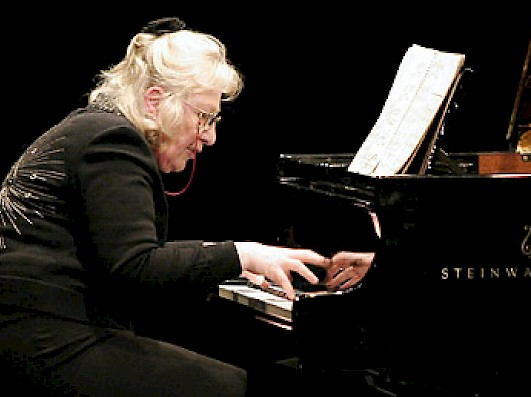by Mike Telin

The concerto, which requires the soloist to play both piano and sampler/synthesizer, is scored for 17 players and live electronics and features the sounds of 40 California birds, including the indigo bunting, orchard oriole, and golden crowned sparrow. The piece also requires a team of three technical assistants who control ring modulators, panning the sound through an eight-speaker surround system. They also control sound processing for the synthesizer and the instruments within the ensemble.
From the beginning, it is easy to understand why Harvey titled the work as he did: this is a concerto for birds. They sing long melodic and rhythmically complex passages, while the piano provides harmonic commentary. Oppens, an expert at making sense of musical complexity, was in full command of her double duty. The work radiates a wide color palette, and the motivic material is constantly in flux. There were many outstanding solo licks from ensemble members, while the accordion, deftly played by Red Wierenga, added a sense of otherworldliness to the overall timbre.
Technical assistants Rachel Gibson, Minh Lam, and Kayla Reagan worked their magic as the birds took flight, traveling from the stage out into the hall and back again. A captivating moment was the manipulation of William Adam’s piccolo solo; he was playing in octaves in real time. Throughout the performance, Weiss provided clear and present leadership.
Jesse Jones’ Snippet Variations is a fascinating sonic excursion during which the composer wittily pokes fun at the music of composers such as Messiaen, Stravinsky, and Copland by borrowing “snippets” of their artistic DNA. Think Elgar’s Enigma Variations. During the eight one-minute variations, I found myself thinking, “Wait, I know that piece — but maybe not.” Clarinetist Richard Hawkins, pianist Liam Kaplan, violinist Jerry Zheyang Xiong, and cellist Jeremy Kreutz gave the work an extremely polished performance.
Christopher Stark writes in the program notes that works by Surrealists painters, including Max Ernst and Salvador Dalí, were the inspiration for his True North. Indeed, his six-minute work for fifteen players (winds, brass, strings, percussion, and piano) is defined by off-kilter fast passages over long, sustained lines.
A large collective of clarinetists took the stage for an acoustic version of Steve Reich’s New York Counterpoint. Under the steady direction of Colin Roshak, the ten-minute, three-movement work seamlessly moved from one complex rhythmic pattern to another. The jazzy syncopations in the last movement interlocked perfectly.
Lee Hyla’s Polish Folk Songs is based on traditional songs of mourning the composer heard at his grandmother’s funeral, but his music plays mind games with the listener. The jovial opening suddenly turns into a memorial service, and the loud, nasal sound of the melodica in the second movement was jarring. The third movement and its lopsided solos brought the work and the concert to a wonderful conclusion.
Published on ClevelandClassical.com April 10, 2018.
Click here for a printable copy of this article

